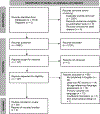Studies pertaining to language impairment in school-age autistic individuals underreport participant socio-demographics: A systematic review
- PMID: 37157821
- PMCID: PMC10592656
- DOI: 10.1177/13623613231166749
Studies pertaining to language impairment in school-age autistic individuals underreport participant socio-demographics: A systematic review
Abstract
Although exclusion of racially and ethnically minoritized autistic individuals from research is a long-standing issue, we have yet to determine how exclusion impacts areas of autism research important for identifying language impairment. Diagnosis depends on the quality of the evidence (i.e. research) and is often the pathway to gaining access to services. As a first step, we examined how research studies related to language impairment in school-age autistic individuals report participant socio-demographics. We analyzed reports using age-referenced assessments in English (n = 60), which are commonly used by both practitioners and researchers to diagnose or identify language impairment. Findings showed only 28% of studies reported any information on race and ethnicity; in these studies, most (at least 77%) of the participants were white. In addition, only 56% of studies reported gender or sex and specified what they were reporting (gender, sex, or gender identity). Just 17% reported socio-economic status using multiple indicators. Altogether, findings indicate broad issues with underreporting and exclusion of racially and ethnically minoritized individuals, which might overlay with other aspects of identity including socio-economic status. It is impossible to determine the extent and precise nature of exclusion without intersectional reporting. To ensure that language in autism research is representative of the autistic population, future research must implement reporting guidelines and broaden inclusion of who participates in research studies.
Keywords: autism spectrum disorder; demographics; language; language impairment.
Conflict of interest statement
Declaration of conflicting interestsThe author(s) declared no potential conflicts of interest with respect to the research, authorship, and/or publication of this article.
Figures
References
-
- American Psychiatric Association. (2013). Diagnostic and statistical manual of mental disorders: DSM-5 (5th ed.). American Psychiatric Association.
-
- American Psychological Association. (2020). Publication manual of the American Psychological Association: The official guide to APA style (7th ed.). Author.
-
- American Psychological Association. (2021). Equity, diversity, and inclusion in APA Journals.Author. Retrieved July 29 from https://www.apa.org/pubs/authors/equity-diversity-inclusion
-
- American Psychological Association Journals. (2021). Equity, Diversity, and Inclusion Toolkit for Journal Editors. Retrieved September 19 from https://www.apa.org/pubs/authors/equity-diversity-inclusion-toolkit
-
- American Speech-Language-Hearing Association. (2022). 2021 Demographic profile of ASHA members providing multilingual services. www.asha.org.
Publication types
MeSH terms
Grants and funding
LinkOut - more resources
Full Text Sources
Medical
Research Materials


